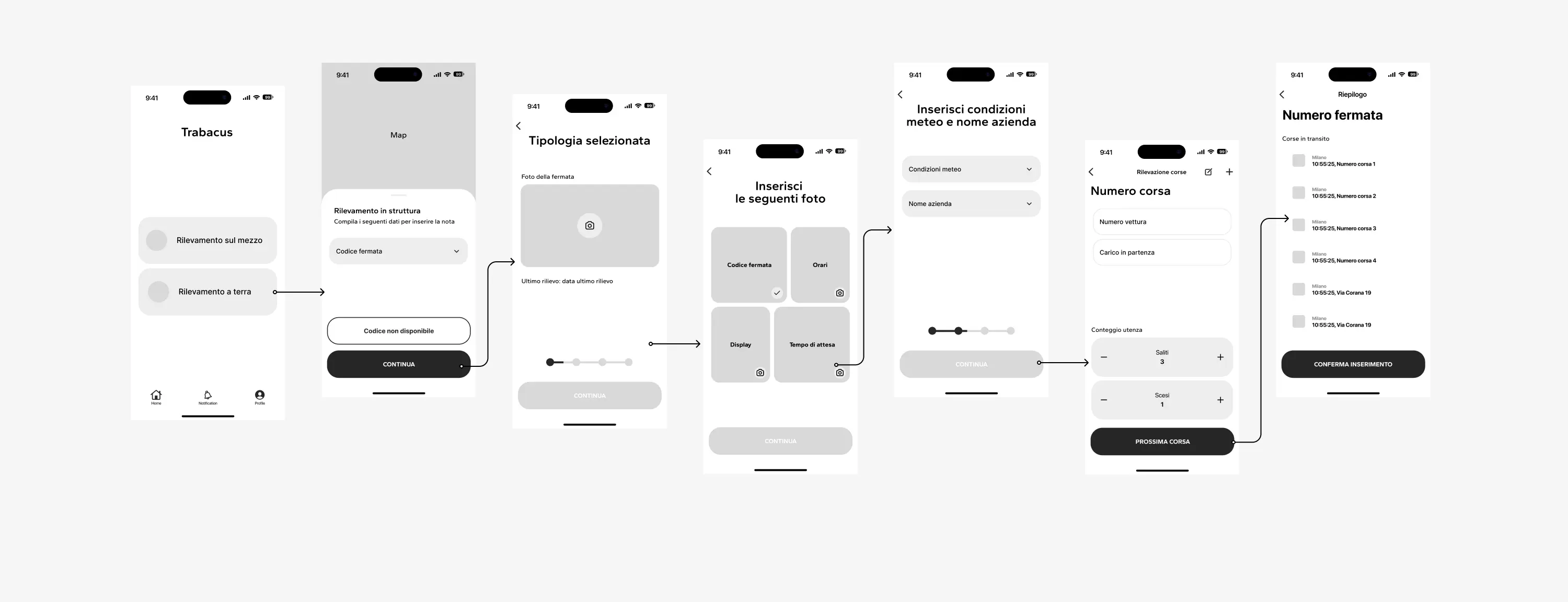
AMAT
For AMAT, we built a mobile app to track passenger boarding and alighting and loading data on Milan’s public transport in real time.
Services:
App Development; UX/UI Design;
Technologies:
Flutter, PostgreSQL, C# .NET 7, Angular 16.
2023 – Ongoing

Project Overview
AMAT, Agenzia Mobilità Ambiente e Territorio, is a technical organization of the Municipality of Milan with an ambitious vision for the future of sustainable mobility. Aware of the importance of adopting modern and innovative solutions, AMAT has taken on the challenge of transforming its public transportation data collection system to improve operational efficiency and reduce environmental impact.
In this regard, a collaboration with Purplesoft has been established to develop the innovative app called Trabacus. This app is designed to detect real-time boarding and alighting data of passengers, as well as the load of public transportation vehicles, using the General Transit Feed Specification (GTFS) standard. The app allows recording and verification of stops, collection of weather data, passenger tracking, and monitoring of regularity.
Furthermore, the app allows for the registration and management of temporary stops, which may not be available in the standard set. It also provides tools for verifying the infrastructure of stops, ensuring that the necessary facilities are in place. During data collection, Trabacus performs various checks to ensure the accuracy of the information and provides various data outputs for analysis.

UX/UI Design
In the Trabacus project for AMAT, our team took on the challenge of revolutionizing the UI/UX of an existing app that had not undergone previous design research. Starting with a series of screenshots of the original app, our designers mapped the existing workflow and identified areas for improvement.
With the gathered information and feedback obtained from interviews with key users, the design team worked on developing a new user interface. This new interface was designed with the goal of better adapting to the practical needs of users and simplifying their daily operations.
The result is a modern and intuitive app with an optimized user experience that directly caters to the needs of the users. This redesign process not only improved the user experience, but also helped make the app more efficient as a whole.

Mobile App Development
We developed the application using an Agile approach, characterized by iterative and incremental cycles. This allowed us to implement changes and improvements continuously based on user feedback and team observations, ensuring a highly adaptive development process.
The core of the Trabacus system is based on PostgreSQL, upon which we have built a robust relational database on the Linux server provided by AMAT. Access to the server requires the installation and configuration of an institutional VPN. A crucial element of this architecture is the integration and management of GTFS data provided on a monthly basis by ATM, the public transportation company of Milan. This information is imported, combined, and synchronized into our system to ensure that the surveys on lines, vehicle shifts, and trips are always aligned with the latest changes published in the feed.
The Web APIs, developed in C# .NET 7, have been designed to be reliable, scalable, and easily maintainable. These APIs serve as a bridge between the system’s backend and the user interface (front-end: app and administration panel), enabling smooth interaction between the two parts.
The front-end side of the system includes a mobile application and an administration panel. The mobile app was developed with Flutter. This allowed us to develop a native Android and iOS app (the iOS platform was not supported in the previous version of the Trabacus app) with a single code-base, speeding up the development process and maintaining a high level of performance.
For the administration panel, we opted for Angular 16. This framework allowed us to create a responsive and intuitive user interface, making it easier for administrators and authorized personnel to manage the system.
Finally, to ensure effective collaboration among our various team members, we implemented Continuous Integration and Continuous Deployment (CI/CD) practices on Azure cloud. These practices allowed us to regularly integrate and test code, ensuring that any errors were detected and resolved quickly.

Results
The Trabacus project demonstrated the value of well-thought-out design and close collaboration between designers and developers. Thanks to these synergies, we were able to transform an existing app with obvious shortcomings into a successful solution, providing an improved user experience and helping to improve the efficiency and quality of public transport services offered by ATM Milano and AMAT.





